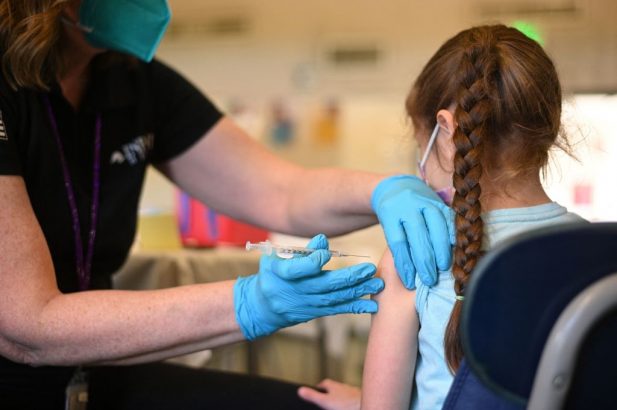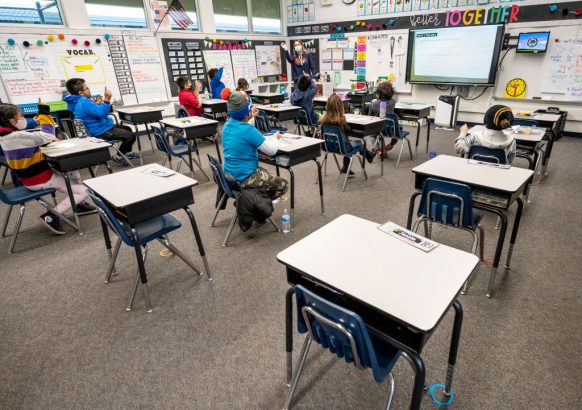This Week in COVID & Education Policy: Pfizer Shots Reduced Kids’ Hospitalizations During Omicron, Alarming New Absenteeism Data & More

This is our weekly briefing on how the pandemic is shaping schools and education policy, vetted, as always, by AEI Visiting Fellow John Bailey. Click here to see the full archive. Get this weekly roundup, as well as rolling daily updates, delivered straight to your inbox — sign up for The 74 Newsletter.
Pfizer COVID-19 Vaccine Reduced Kids’ Hospitalizations During Omicron: New study that analyzed 1,185 case patients, 88% of whom were unvaccinated, 25% of whom received life support and 14 of whom died. The study has 1,627 controls.
- “Overall, 88% were unvaccinated and 25% were critically ill and required life support measures such as intubation. Among 5- to 11-year-olds, 92% were unvaccinated and 16% were critically ill. Of those who were critically ill, 90% were unvaccinated.”
- “Among 12- to 18-year-olds, 87% were unvaccinated and 27% were critically ill. Of those who were critically ill, 93% were unvaccinated. Two patients in this age group died.”
- “The effectiveness of two doses of Pfizer against any hospitalization for COVID-19 was lower during the Omicron period than during the Delta period in adolescents 12 to 18 years of age, but vaccination prevented most life-threatening COVID-19 in both periods. Vaccination also reduced the risk of hospitalization for COVID-19 among children 5 to 11 years of age by two-thirds during the Omicron period, and most children with critical COVID-19 were unvaccinated.”
- Via The New York Times: “‘While any hospitalization is unnerving, it is reassuring that the vaccines still protected children from the worst outcomes of infection,’ said Dr. Manish Patel, a researcher at the Centers for Disease Control and Prevention who led the study.”
- More via Center for Infectious Disease Research and Policy

April 8, 2022 — The Big Three
Exclusive Enrollment Data Shows Students Continue to Flee Urban Districts as Boom Town Schools and Virtual Academies Thrive: The 74 analyzes Burbio data.
- “New York experienced the sharpest decline, a 2% drop — more than 48,000 students — since last year. That’s on top of the previous year’s 3% decline. Enrollment in Florida saw the biggest bounce at 4%, or more than 111,000 additional students — a reflection of higher birth rates, job growth and fewer COVID restrictions.”
- “ ‘Federal [relief] money is delaying it a year or two, and the fact that state budgets are healthy is delaying it a year or two,’ said Marguerite Roza, director of the Edunomics Lab at Georgetown University, about closing schools. Roza advises a network of over 40 urban districts nationwide, the majority of which are shrinking. ‘Federal money will run out, and enrollment for some of them isn’t isn’t going to come back. These cost factors are going to just slam down on people.’ ”

Student Absenteeism Has Surged: Via Axios
- In Los Angeles, 46% of students in Los Angeles Unified have been chronically absent this year or have missed at least 9% of the academic year, according to the L.A. Times.
- In New York City, the rate of chronic absenteeism soared to 40% — up from 26% during the 2018-19 school year, according to the New York Post.
- In Ohio, the statewide chronic absenteeism rate rose to 24% in 2020-21, the most recent school year for which there is data, up from 11% in 2019-20, according to state data.
Incidence Rates and Clinical Outcomes With the Omicron and Delta Variants in Children Younger Than 5 Years: New study in JAMA.
- “Results of this cohort study suggest that the incidence rate of SARS-CoV-2 infection with Omicron variant was 6 to 8 times that of Delta variant in children younger than 5 years, but severe clinical outcomes were less frequent than with Delta variant.”
- This cohort study included a total of 651, 640 children younger than 5 years.
- “Incidence rate of Omicron infection was higher in children aged 0 to 2 years than in those aged 3 to 4 years.”
- “Omicron cohort was younger and with fewer comorbidities than Delta cohort, but differences were eliminated after matching.”
Federal Updates
COVID Supplemental: Is delayed again:
- Punchbowl News: “Senators in both parties have come to the conclusion that there simply isn’t enough time to pass the $10 billion COVID bill this week” because Ketanji Brown Jackson’s confirmation was “the overwhelming priority for both [Sen. Charles] Schumer and President Joe Biden.” (The Senate confirmed Jackson Thursday afternoon.)
- “That means the COVID prep bill – which the White House has been demanding for months – gets shelved once again. It’s the second time in recent weeks this has happened to Democratic congressional leaders, although in this case it was a dispute over immigration and border security that forced the delay, not an internal party revolt. This is a defeat for the White House and Hill Democratic leadership, which has been shouting that it needs this money.”
- Politico: COVID deal hampered by GOP opposition to Biden immigration policy.
White House: Fact sheet: The Biden Administration Accelerates Whole-of-Government Effort to Prevent, Detect and Treat Long COVID. More via the Washington Post.
City & State News
California: “Student math scores touch off five-alarm fire”
- Analysis finds average eighth graders may have skills indicative of fifth grade.
- “The results raise doubts whether traditional strategies like summer school and tutoring can succeed in making up such a huge gap in learning.”
Colorado: Colorado Springs-area school districts battle teacher shortage.
- “In the final quarter of the 2021-22 school year, districts in the Colorado Springs area and across the state face a different challenge: a shortage of teachers and staff that has some employees and families concerned for the immediate future.”
- “According to Colorado Department of Education data, Pikes Peak-area school districts have more than 400 vacant teaching jobs, with Academy School District 20 — the region’s largest — showing more than 140 vacancies.”
Illinois:
- Gov. J.B. Pritzker signs bill creating paid COVID sick leave for all vaccinated school employees.
- The Illinois State Board of Education last month announced a $17 million grant to create the nation’s first state-funded Freedom Schools network, which aims to supplement learning in school with a research-based, multicultural curriculum taking place over the summer and/or the school year.
New York: Gov. Kathy Hochul launched new ads featuring pediatricians encouraging parents to get their children vaccinated.
North Carolina:
- Charlotte-Mecklenburg Schools announced it will offer virtual learning to more students starting with the 2022-23 school year.
- Guilford County Schools launches free Tutor Helpline to address learning loss.
Ohio:
- “About 80% of Ohio schools that were eligible for wellness and mental health services funding took advantage of it last school year, and they spent a combined $289 million on that programming, according to the Ohio Department of Education.”
- Ohio’s eight PBS stations will be working with local summer and afterschool program staff from across the state to help address learning disruptions.
- “Through a new partnership with the Ohio Department of Education, Ohio Learns 360 will provide programs with PBS resources, including standards-based curriculum and materials, virtual field trips, interactive video programs, community events and more, all designed to accelerate student learning and support the state’s most vulnerable learners.”
COVID-19 Research
FDA Advisers Struggle With How to Move Forward on COVID Boosters:
- Stat live blogged the meeting: “The big message from the panel was that there is not a clear framework in place for approving vaccines aimed at new SARS-CoV-2 variants or deciding when people will need an additional dose of vaccine. But the panel was also clear that there is a real need to figure out what to do ahead of the fall and winter, when a surge is most likely.”
- NBC: “[Dr. Peter] Marks of the FDA suggested an approach similar to how the flu shot is made each year, in which World Health Organization scientists constantly monitor influenza strains and, every year, select three to four that they think will be circulating widely to include in the flu vaccine.”
- CNBC: “Leading U.S. scientists and physicians worry that the FDA and CDC are moving too fast in approving a fourth round of COVID shots, with little public debate that gives the vaccine makers too big a role in setting the pace with which the doses are distributed across the nation.”
EU Regulators on Booster: European regulators conclude it’s too early to consider fourth dose for the general population, but agree one can be given to people age 80-plus.
What We Know about Omicron’s BA.2 Variant So Far: Via Scientific American
Cardiac Complications After COVID-19 Infection and mRNA COVID-19 Vaccination: CDC weekly report: The risk of heart complications was higher after having COVID-19 than after getting one or more mRNA COVID-19 vaccines, among males and females of all ages.
Effect of Early Treatment With Ivermectin Among Patients With COVID-19: The largest randomized, double-blind study yet conducted, with early treatment, indicates there is no difference compared with placebo. More via the NYT.
Mental Health, Suicidality and Connectedness Among High School Students During the COVID-19 Pandemic: CDC study.
- “Thirty-seven percent of high school students reported poor mental health during the COVID-19 pandemic, and 44% reported feeling persistently sad or hopeless.”
- “19.9% had seriously considered attempting suicide, and 9.0% had attempted suicide.”
Low Vaccination Rates for Children:In about half of US counties, less than 10% of children ages 5 to 11 are fully vaccinated against COVID-19
- “About 1,500 counties have less than 10% of this age group vaccinated, including more than 500 counties that have less than 5% of this age group vaccinated, according to CNN’s analysis.”
Viewpoints
Districts Struggle to Transport Students Amid Ongoing Bus Driver Shortage:
- “ ‘You just saw it all over the country, there were districts that had to go remote because they didn’t have bus drivers. There were districts that reduced service and increased walk boundaries,’ said Joanna McFarland, CEO and founder of HopSkipDrive, a school ride service that operates a fleet of cars and SUVs in 10 states.”
- “According to a newly released survey from HopSkipDrive, 88% of survey respondents said the bus driver shortage is the biggest transportation issue they face — a 10% increase from last year. 67% said they saw a direct link between access to transportation and attendance in their district.”
How COVID-19 Caused a Global Learning Crisis: Via McKinsey
- “The length of school closures varied widely across the world. School buildings in middle-income Latin America and South Asia were fully or partially closed the longest — for 75 weeks or more. Those in high-income Europe and Central Asia were fully or partially closed for less time (30 weeks on average), as were those in low-income sub-Saharan Africa (34 weeks on average).”
- “On average, students globally are eight months behind where they would have been absent the pandemic, but the impact varies widely, with countries falling into three archetypes:
- High-performing systems, with relatively high levels of pre-COVID-19 performance, where students may be about one to five months behind due to the pandemic (for example, North America and Europe, where students are, on average, four months behind).
- Low-income prepandemic-challenged systems, with very low levels of pre-COVID-19 learning, where students may be about three to eight months behind due to the pandemic (for example, sub-Saharan Africa, where students are on average six months behind).
- Pandemic-affected middle-income systems, with moderate levels of pre-COVID-19 learning, where students may be nine to 15 months behind (for example, Latin America and South Asia, where students are, on average, 12 months behind).”
- “Lower levels of learning translate into lower future earnings potential for students and lower economic productivity for nations. By 2040, the economic impact of pandemic-related learning delays could lead to annual losses of $1.6 trillion worldwide, or 0.9% of total global GDP.”
- “Many systems are reemphasizing the importance of caring for the whole child. Integrating social-emotional learning for all students, providing trauma-informed training for teachers and staff, and providing counseling and more intensive support on and off campus for some students could provide supportive schooling environments beyond immediate crisis support.”
The Hunt Institute: Released a series of resources:
- Closing the Digital Divide: Strategies to Connect Students & Families
- Whole Child Education: Supporting Students’ Learning and Development
- Human Capital for the 21st Century: Aligning Education with Future Workforce Needs
- COVID Constituency Parent Narratives
- The COVID Constituency: Emerging Priorities for Education Leaders
The First Five Years Fund: Released findings from a poll of likely voters in seven battleground states.
Accelerate: Incubated and launched at America Achieves and supported by a coalition of partners and funders, is leading a national effort to design,launch, improve and scale high-impact tutoring efforts and to build a community committed to impact and shaping the evidence base for tutoring.
Course Choice: The ideal postpandemic policy solution, via Michael Brickman.
Federal Broadband Funding Opportunities: Super-helpful chart from Common Sense Media.
To Close Pandemic Academic Gaps, Experts Point to a ‘Cascade’ of Skills Young Kids Will Need To Work On: Via The 74
Hidden Loss, Hidden Pain: Bruno Manno on how philanthropies and donors can help children who have lost a parent or caregiver to COVID-19.
…And on a Reflective Note
Free: John Legend performed “Free” at the Grammys along with Lyuba Yakimchuk, Siuzanna Iglidan, Mika Newton and a choir.
Bears: Enjoying their spring break.
View this post on Instagram
ICYMI @The74
Weekend Reads: In case you missed them, our top stories of the week:
- Ukraine: A Month Into Russian Invasion, Fear Grips Ukrainian Students in the U.S. With No Clear Path Home
- Opinion: Why Should a College Education Start at Age 18, and only after HS? Time to Change the ‘When’ & ‘Who’ of College
- Florida: With Last-Minute Changes, Florida’s ‘Stop WOKE’ Bill Establishes Limits on Classroom Instruction Some Experts Call ‘Flatly Unconstitutional’
- Leadership: Fears of a School Superintendent Exodus: With Data Revealing Massive Pandemic Turnover, New Survey Shows Another 1 in 4 Leaders Expect to ‘Leave Soon’
For even more COVID policy and education news, subscribe to John Bailey’s daily briefing via Substack.
Disclosure: John Bailey is an adviser to the Walton Family Foundation, which provides financial support to The 74.
Help fund stories like this. Donate now!

;)
